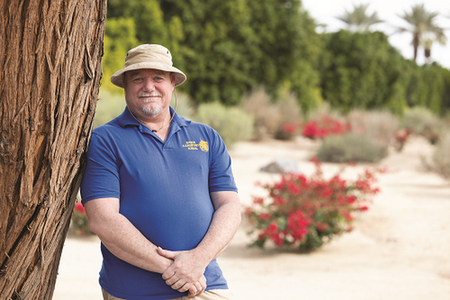The Dark Side of Sun Exposure
Prevention, screening and treatment may save your life

“I worked in construction most of my life, so I was out in the sun all the time,” says the 52-year-old 29 Palms resident. He’d also served in the Navy and spent a lot of time outdoors in other warm, sunny climates. Lien admits he never gave much thought to protecting himself from the sun’s damaging ultraviolet (UV) rays by wearing a hat or sunscreen.
Then, in 2021, a skin lesion appeared above his right eyebrow. He went to see a dermatologist who suspected that it was skin cancer and would require more advanced treatment than he was able to provide. He recommended that Lien see an oncologist. Lien’s primary care physician referred him to Constantin Dasanu, MD, PhD, who is Board Certified in Hematology/Oncology and specializes in treating skin cancer.
“We see patients with melanoma, squamous, basal and Merkel cell cancers, usually when these cancers are advanced and dermatological surgery cannot remove them,” Dr. Dasanu explains. “By the time we saw Mr. Lien in the spring of 2022, the lesion on his forehead was like a golf ball, about six centimeters (2.36 inches) in diameter.”
What’s more, it had developed ulcerations — open sores — and was, as Dr. Dasanu characterizes it, “nodular, ugly and bleeding a lot; the flesh was decomposing.”
A biopsy revealed that Lien had cutaneous squamous cell carcinoma, a common form of skin cancer that develops in the squamous cells that make up the middle and outer layers of the skin. While usually not fatal, it can be aggressive, growing large or spreading to the lymph nodes or other organs and causing serious complications. It’s caused by prolonged exposure to UV radiation, either from sunlight or tanning beds.
“We performed a CT scan of Mr. Lien’s head which showed that the cancer hadn’t gone into the bone or brain, but it had spread significantly under his skin,” Dr. Dasanu says. “A CT of his neck showed that there was no lymph node involvement, however, which was good.”
Most squamous cell skin cancers are found and treated in their early stages, when they can be surgically removed or destroyed with radiation therapy. In fact, small squamous cell cancers usually can be cured with these treatments. But larger squamous cell cancers like Lien’s are more difficult to treat.
Because of the extent of Lien’s cancer, he wasn’t a candidate for surgery or radiation therapy. “He needed systemic treatment,” Dr. Dasanu says.
Immunotherapy
The immunotherapy drug that Dr. Dasanu used to treat Lien is cemiplimab (Libtayo®). It is what’s also known as a PD-1 inhibitor. It works by targeting PD-1, a checkpoint protein on T cells (a type of immune system cell) that normally helps to prevent these cells from attacking other cells in the body. By inhibiting (blocking) PD-1, cemiplimab can boost the immune response against cancer cells.
“We started Mr. Lien on cemiplimab right away in April 2022, giving him the medicine by infusion every three weeks,” Dr. Dasanu says. “After just one dose, he had a dramatic response — his tumor decreased in size by fifty percent. After the second and third doses, it shrank even more, and after four or five doses, it was no longer elevated above his skin. After six doses, there was virtually nothing left.
“In September, we did a PET scan that was negative for any disease activity,” he continues. “We usually see a forty to fifty percent response rate with PD-1 inhibitors. His response to immunotherapy was spectacular.”
At this writing (December 2022), Lien was slated to have one more immunotherapy treatment and had been referred to a radiation oncologist for an evaluation to address a small remaining nonhealing lesion on his forehead. He also was scheduled to see a plastic surgeon to repair the scar tissue above his right eye. Going forward, he will see his dermatologist every three months for surveillance. And he is taking the preventive measures recommended by his multidisciplinary care team very seriously.
“I’m basically retired from outside work and mostly stay inside during the day,” he says. “When I do go out, I wear hoodies, hats, long sleeves and sunscreen. And I walk my dog in the evening.”
“An ounce of prevention is worth a pound of cure,” Dr. Dasanu says. “Be especially careful of the sun’s damaging power from May through October here in the desert, particularly if you are fair-skinned with blue or green eyes. And wear sunscreen with an SPF of 50.”
“Skin cancer is no joke,” Lien adds. “You need to protect yourself from the sun and take your health seriously. Plus, if you notice anything wrong, get it checked out immediately. I delayed it and it was almost too late.”
For more information or to contact Eisenhower Lucy Curci Cancer Center, call 760.674.3602 or visit EisenhowerHealth.org/Cancer.



